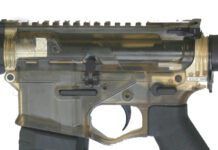Remember that daylight bank robbery in California a few months back? The bad guys were illegally armed to the teeth, wearing body armor and spraying lead in all directions. If there had been a movie crew around, one might have thought they were filming Lethal Weapon 4.
If you saw the TV news coverage, the image of one armored bandit being dropped in his tracks will probably stay with you a long time. That shot was taken with a rifle capable of MOA (minute of angle) accuracy at 100 yards. In the hands of law enforcement, they’re called sniper rifles. The rest of us call them target or varmint rifles. Except for finish and perhaps some high tech, highly expensive add-on optics, they’re much the same.
The subjects of this test, the Remington Model 700 Police and the Savage Model 110FP Tactical, are two such rifles. These bolt action rifles are intended for tactical use, but they are also suitable for varmint hunting and target shooting. We evaluated the .308 Winchester versions of these models in the November 1996 issue. This time around we decided to try the .223 Remington variants.
Savage builds their Model 110FP Tactical the way it builds all their heavy-barrel target rifles. Chambers are tight with shallow leade. Headspace is on minimum gauge for full bearing on both bolt lugs. Every rifle receives an out-the-door check to assure no more than 0.002 above minimum and firing pin protrusion is adjusted for every individual bolt head. Remington’s Model 700 Police uses the same solid action as their varmint rifle, smooth ground sear and connector surfaces and an HS Precision stock with an integrated bedding block.
Here’s how the Remington and Savage performed when we evaluated them head-to-head:
Remington Model 700 Police
The Model 700 Police is a tactical rifle intended for use by law enforcement agencies. In .223, this $780 bolt action rifle features a heavy 26-inch barrel, a 5-round internal magazine with a hinged floorplate and a composite stock reinforced with Kevlar and fiberglass. The stock has an aluminum bedding block and three swivel studs to accommodate both a sling and a bipod. A .308 Win. variant with a removable 4-shot magazine, the Model 700 Police DM, is also available.
Physical Description
Our Model 700 Police’s workmanship was very good. All of its steel parts had a uniform blue/black matte finish. The trigger guard and hinged floorplate were aluminum alloy with a similar black finish. No tool marks or sharp edges were present. Moving parts had little or no play.
The specially-designed black synthetic stock had a fully textured finish that was non-reflective and slip resistant. Its three blued steel swivel studs and black rubber recoil pad were expertly installed. The stock was solidly attached to the action, and its barrel channel was relieved enough to permit the barrel to float freely. There was some space between the sides of the receiver and stock, but this was intentional and not bothersome. The magazine assembly and trigger guard were carefully inletted.
Our Judgments
This Remington functioned flawlessly with the three kinds of commercial ammunition we tried. Bolt movement was very smooth and easy. Loading rounds into the internal magazine through the ejection port didn’t present any problems, and unloading it was a simple matter of releasing the hinged floorplate.
Our shooters found that the Model 700 Police’s muzzle-heavy balance provided excellent muzzle stability, but made pointing and target acquisition relatively sluggish. Shouldering was smooth and natural. The straight comb afforded a stable stockweld with good cheek and jaw contact. The wide pistol grip, which had dual palm swells, was comfortably-shaped and allowed a solid grasp. The semi-beavertail forend sat squarely in the support hand or on a rest. Felt recoil was significantly milder than on a standard rifle, which quickened shot recovery.
All of this rifle’s controls operated positively. When pushed forward, the floorplate catch at the front inside of the trigger guard unlocked the hinged floorplate. Pushing up the bolt release, a small tab in front of the trigger inside the trigger guard, allowed the bolt to be removed from the receiver.
The manual safety was a two-position lever located behind the bolt handle on the right side of the receiver. When moved rearward to the engaged position, it blocked the trigger but not the bolt. So, the safety could be engaged when loading and unloading the rifle. There was no cocking indicator, but the firing pin protruded from the back of the bolt noticeably when cocked.
We felt the movement of the grooved 3/8-inch-wide trigger was a little heavy, but otherwise acceptable for the rifle’s intended use. It had no slack and a crisp 4-pound release. There was only a minor amount of overtravel.
Holes were drilled and tapped into the top of the Model 700 Police’s receiver to accommodate a scope mount. For testing, we installed a Burris 3-9x Fullfield scope on the rifle using a one-piece base and a set of rings that weren’t provided with the gun. Open sights aren’t available on this model.
In our opinion, this rifle’s accuracy was satisfactory for tactical duty with the right ammunition. The best three-shot average groups of the test, 0.82 inch at 100 yards, were produced with Federal Gold Medal 69-grain boat-tail hollow points. However, using Remington 55-grain pointed soft points and Winchester 64-grain Power Point soft points, groups opened up to 1.28 and 1.85 inches, respectively.
Chronographing showed this Remington yielded muzzle velocities that averaged from 2,975 to 3,129 feet per second. We considered these speeds to be more than acceptable for a .223 rifle with a 26-inch barrel.
Savage 110FP Tactical
Retailing for $439, the Savage Model 110FP Tactical in .223 is a moderately-priced bolt action tactical rifle. It features a heavy 24-inch barrel, a fixed 5-round magazine and a composite stock filled with graphite and fiberglass. The stock is pillar bedded and has three swivel studs to allow the installation of a bipod and a sling. This model is also available in five other calibers from .25-06 Remington to .300 Winchester Magnum. The Model 110FLP, a left-hand version, is also made.
Physical Description
The Model 110FP was, in our opinion, a comparatively plain-looking rifle with average workmanship. Its laser-etched bolt had a black titanium nitride coating for extra corrosion resistance and smoothness. Other steel parts, including the trigger guard, had a dull blue/black finish. Numerous tool marks were noted on the interior of the receiver, especially in the bolt raceway. Most moving parts had a moderate amount of play.
One of the ways Savage kept this rifle’s cost down was by equipping it with a standard black synthetic stock. It had a smooth non-reflective finish and molded checkering. The three blued steel swivel studs, the rubber recoil pad and the plastic grip cap were neatly installed.
The stock was securely attached to the action, but they weren’t mated well. Small gaps were noted along the left side of the trigger guard and both sides of the receiver. According to the manufacturer’s literature, the barrel was supposed to float freely. Our test gun’s barrel didn’t.
Our Judgments
We couldn’t fault the Model 110FP’s operation. It reliably fed and fired all of the commercial ammunition used. Bolt movement was reasonably smooth, though it rubbed on the magazine’s plastic follower. The internal magazine, which had a spacer at the rear to properly position .223 cartridges, wasn’t difficult to load. But, repeatedly cycling the action was the only way to unload the magazine.
In our opinion, this Savage’s handling qualities were only adequate for a tactical rifle. Its balance was less muzzle-heavy than the Remington Model 700 Police, resulting in less muzzle stability. But, pointing and target acquisition were faster. The straight comb afforded a stockweld with good jaw contact, but not much cheek contact. The tapered forend afforded only a minimum of stability when on a rest, but it and the thin pistol grip allowed a firm grasp. Felt recoil was a little heavier than the Remington.
Right- and left-handed shooters could readily manipulate the manual safety, a three-position slide on the tang, with the thumb of their firing hand. When pulled all the way to the rear, the safety blocked the bolt and locked the trigger. In the mid-position, it blocked the trigger but allowed the bolt to be moved for loading and unloading. Pushing the safety fully forward disengaged it.
The Model 110FP’s other control, the cocking indicator, was a blued steel lever in front of the bolt handle on the right side of the receiver. It raised when the action was cocked. Also, depressing this lever and pulling the trigger allowed the bolt to be withdrawn from the receiver.
None of our shooters were satisfied with the movement of the ungrooved 1/4-inch-wide trigger. Its pull had some slack, a mushy release and moderate overtravel. According to our self-recording gauge, it let off at 4 3/4 pounds.
This model wasn’t available with open sights, but the top of its receiver was drilled and tapped for a scope mount. Using a one-piece base and a set of rings that weren’t provided with the rifle, we equipped the gun with a Burris 3-9x Fullfield scope for accuracy testing.
We considered this Savage’s accuracy to be barely acceptable for its intended use. Three-shot average groups produced with Federal Gold Medal 69-grain BTHPs averaged 1.05 inches at 100 yards. The Winchester and Remington loads yielded groups of 1.28 and 1.38 inches, respectively.
Since this Savage’s barrel was two inches shorter than that of the Remington Model 700 Police, its muzzle velocities were from 28 to 87 feet per second slower. We felt this was a minor disadvantage.




























